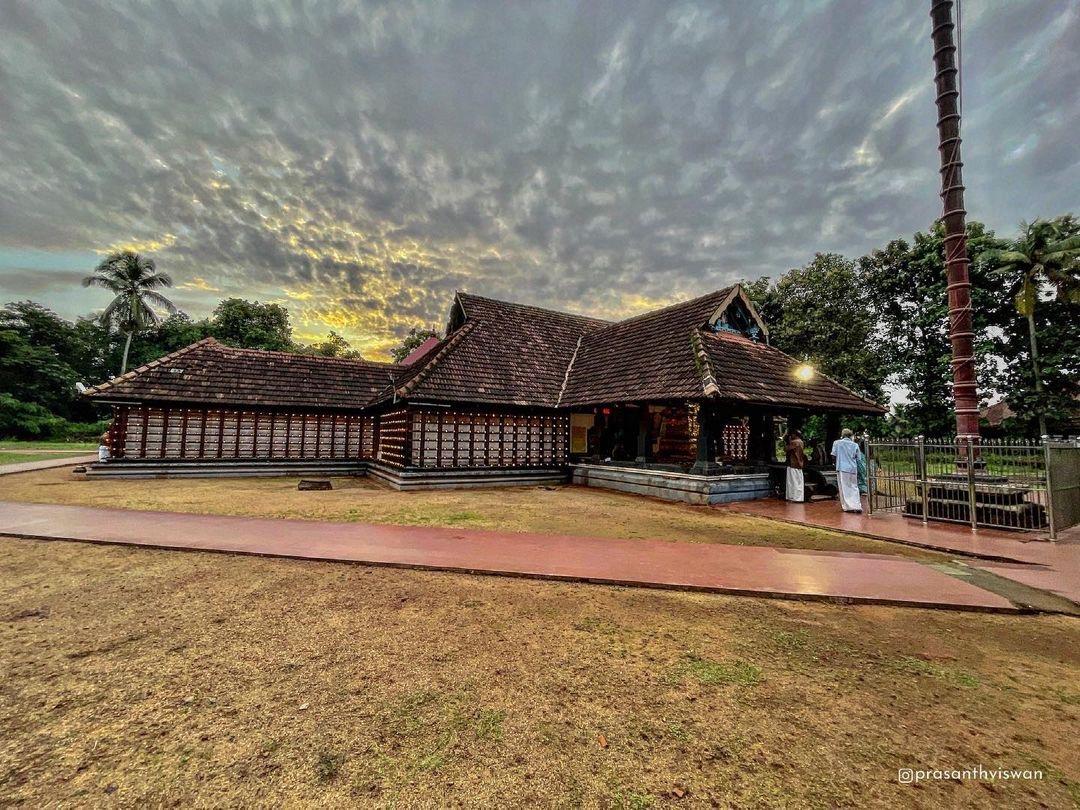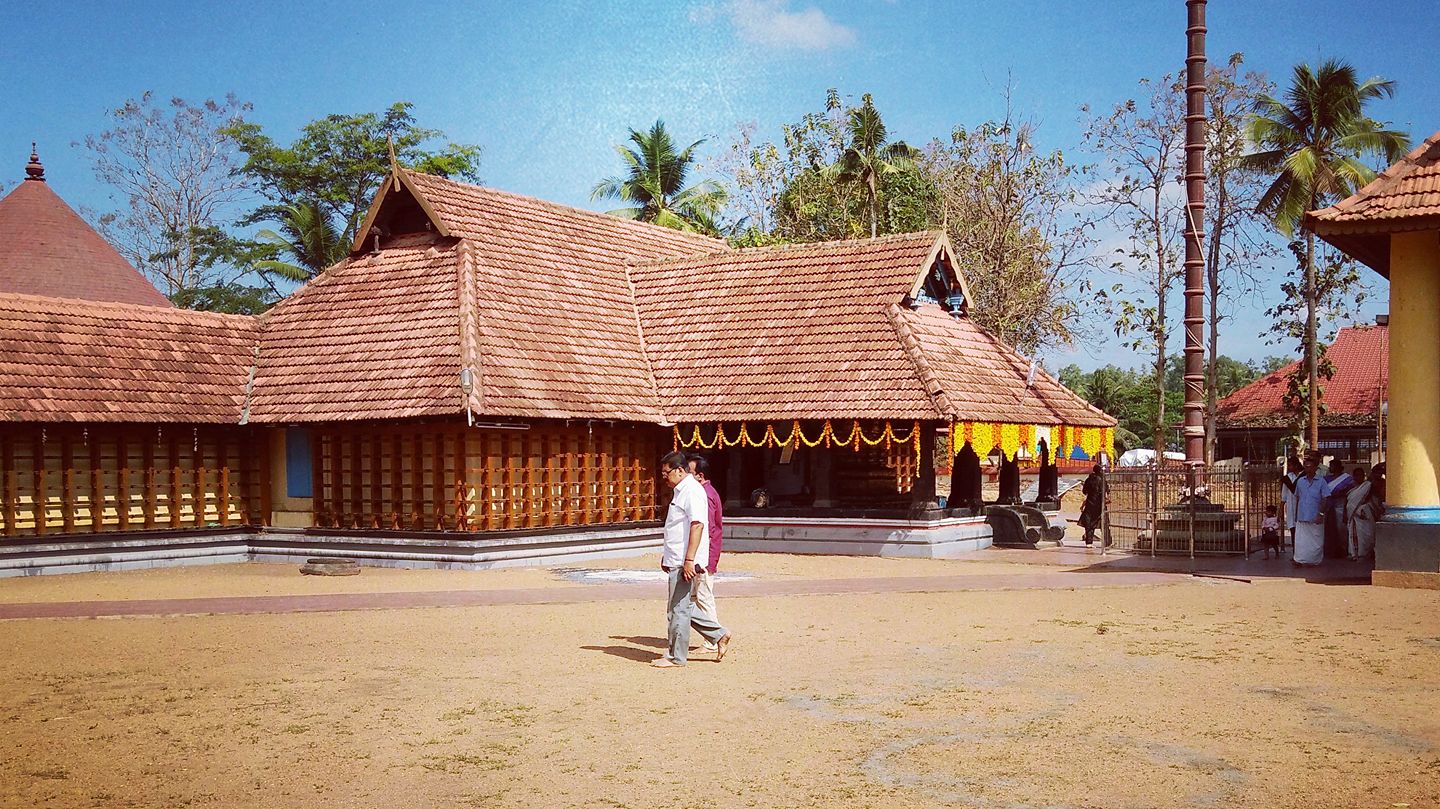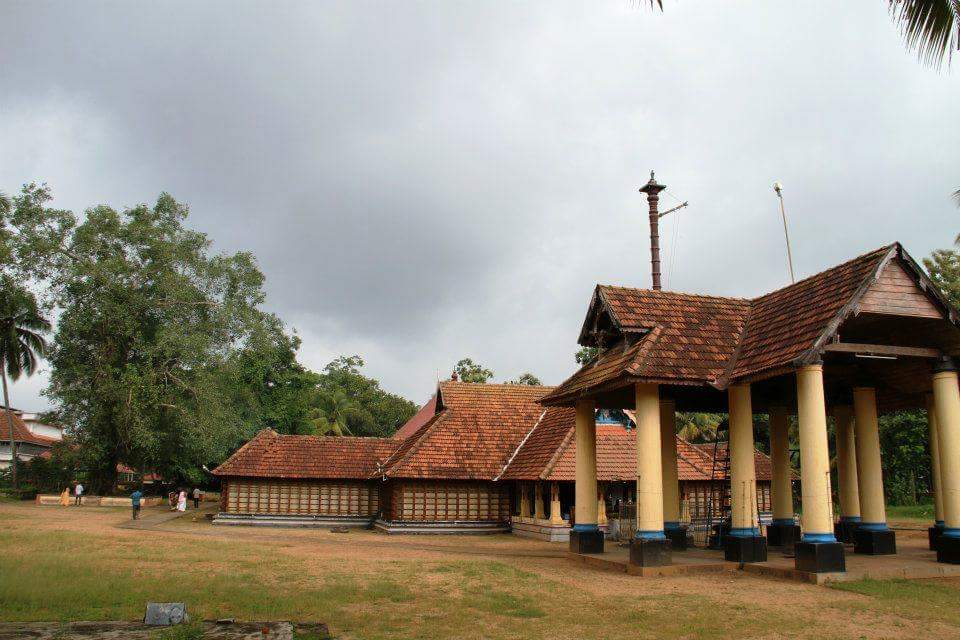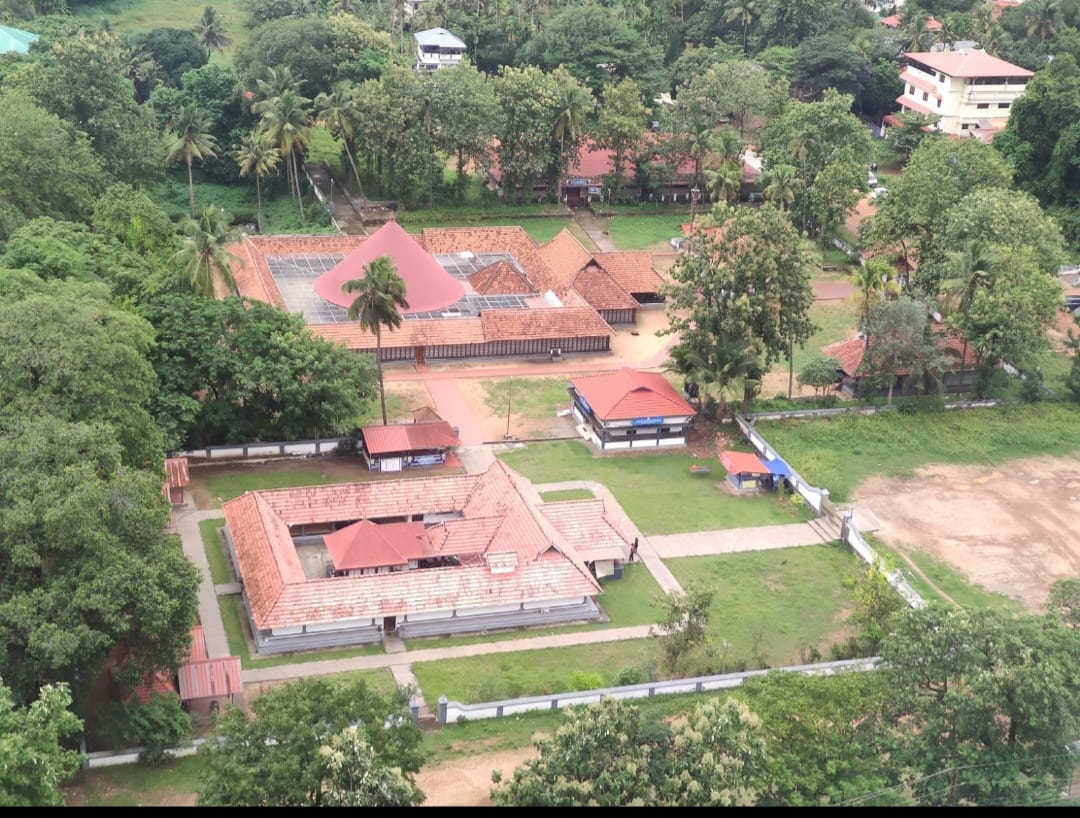Thrikkakara Vamanamoorthy Temple is one of the most prominent Hindu temples in India dedicated to Vamana, the fifth incarnation of Lord Vishnu.

Located in Thrikkakara, Kochi, Kerala, the temple is believed to be around two millennia old and is also listed among the 108 Divya Desams (sacred Vishnu temples). The temple is most famous for its grand Onam celebrations, held in August or September, which mark the most significant event in its religious calendar.
Historically, after the East India Company and Marthanda Varma annexed the region from the Kingdom of Kochi, the Onam festival was organized by 61 Naduvazhis (local rulers) under the leadership of the Maharaja of Travancore until India's independence. Even today, the celebrations reflect communal harmony, with people of all religions participating in the Onasadya (Onam feast) and other festivities. Besides Onam, the temple also observes other important Hindu festivals such as Vishu, Makara Sankranti, Navaratri, and Saraswati Puja.
Thrikkakara Vamanamoorthy Temple complex is spread over a vast area, with the main sanctum dedicated to Vamana. The idol of Vamana is depicted in the act of placing his foot on the Asura King Mahabali. According to legend, the temple was established by Parashurama. Records found in the temple contain the earliest known references to the Onam festival, dating back to 861 CE. The temple is currently managed by the Travancore Devaswom Board. The sub-deities of the temple include Bhagavati, Sasthavu, Gopalakrishna, Nāga, Brahmarakshasa, and Yakshi.
Brahmarakshasa shrine is situated in the outer complex, along with a Banyan-tree deity (Aaldevata) and the Sarpa Kavu, a sacred grove for serpent worship. Surrounding the inner sanctum is a series of thousands of lamps called Chuttuvilakku, meaning "surrounding lamps." The temple also has two ponds: Kapilatheertham, located inside the temple complex on the northern side of the sanctum and accessible only to priests, and another pond outside the northern temple walls, used for the Aaraattu ceremonial bath during Onam celebrations.
Adjacent to the main Vamana temple is a Shiva temple that was renovated in 2014. It houses idols of Shiva, Ganesha, Karthikeya, and Durga, though its exact historical origins remain unclear. Apart from the shrines and ponds, the temple complex features three performance halls called Naimishaaranyam and a temple auditorium at the southwest corner, which is used for cultural events, weddings, and the grand Onam feast during the festival.
Bhagavata Purana narrates the story of Vishnu’s incarnation as Vamana to restore the authority of Indra over the heavens, which had been taken over by Bali, a noble and generous Asura King. Bali, the grandson of Prahlada and son of Virochana, was renowned for his righteousness and devotion. Through severe austerities and penance, he gained immense power and was highly praised by the world. However, flattered by his courtiers and followers, he began to perceive himself as the supreme ruler of all realms.
Vishnu took the form of Vamana, a short Brahmin boy carrying a palm-leaf umbrella, and approached Bali, requesting three paces of land.
Despite the warnings of his guru, Sukracharya, Bali granted the request. At that moment, Vamana revealed his divine identity and expanded into the gigantic Trivikrama form, covering the three worlds with his strides. His first step spanned the heavens to the earth, and his second step extended from the earth to the netherworld. As Bali was unable to fulfill his promise of three paces, he humbly offered his own head for the final step.
In recognition of his humility and devotion, Vamana placed his foot on Bali’s head and granted him immortality.
After worshiping Mahabali and his ancestor Prahlada, Vamana assigned him the sovereignty of Rasatala, one of the netherworlds. Some texts also suggest that instead of sending Bali to Rasatala, Vishnu granted him the boon to become the next Indra. In his expanded, cosmic form, Vamana is revered as Trivikrama, the one who strides across the universe. According to another legend, a wealthy man who owned a plantain grove was troubled by the poor yield of his trees. In an act of devotion, he donated a set of plantains to the temple. Miraculously, after this offering, his grove began to yield golden plantains, and the place came to be known as Nentiram Palam.
Hearing of this extraordinary transformation, the ruling king grew suspicious and believed that the wealth of the grove rightfully belonged to him. In his quest for answers, he captured and tortured a sage, hoping to uncover the secret behind the golden plantains. Angered by the king’s actions, the sage cursed him. Overcome with fear and remorse, the king sought guidance from a group of sages. They advised him to construct a thatch of bamboo and light a lamp using Koraipul grass as an offering. Following their instructions, the king was finally freed from the curse.
Thrikkakara Temple is regarded as the focal point of Onam celebrations, as it is believed to be the legendary abode of King Mahabali. The temple's main festival is the grand ten-day Onam celebration, held in the Malayalam month of Chingam. The presiding deity of the temple is Lord Vamana, the fifth incarnation of Lord Vishnu.
During the Onam festivities, a pyramidal statue representing both Mahabali and Vamana, known as Thrikkakara Appan, is installed at homes and celebration sites as a mark of respect. The temple holds great mythological significance as it is believed to be the place where Vamana placed his foot on King Mahabali, sending him to the netherworld (Patala), thereby marking the origin of the Onam festival.
The name Thrikkakara itself is derived from the words Thiru-kaal-kara, meaning "place of the holy foot," reinforcing the temple's deep connection to the Onam legend. Onam festival at Thrikkakara Temple features several unique traditions. The celebrations begin with the Kodiyettu (flag-hoisting) ceremony on the first day, Atham, which is a common ritual in Kerala temples. The ten-day festival concludes with the ceremonial Aarattu, where the idol is bathed, marking the lowering of the flag and the symbolic farewell to King Mahabali.
A highlight of the festival is the Chaarthu, the daily decoration of the Vamana idol using sandalwood paste, ornaments, and clothing. Each day, the idol is adorned in the form of one of the ten avatars of Vishnu, including Matsya, Kurma, Varaha, Narasimha, Vamana, Parashurama, Rama, Balarama, Krishna, Kalki, and Trivikrama.
Pakalpooram is a grand procession held on the ninth day, where the idol of Vamana is taken around the temple premises on a caparisoned elephant, accompanied by eight other decorated elephants and Panchavadyam (traditional temple orchestra). On the final day, a similar procession called Seeveli takes place, stopping at all four temple gates—East, West, North, and South—before returning the idol to the sanctum. The procession is reminiscent of the grand celebrations at the Guruvayur Temple, adding to the festive grandeur of Thrikkakara’s Onam celebrations.
A key highlight of the Onam festival at Thrikkakara Temple is the grand Onam Sadya (banquet), held on the last two days of the festival. This feast, which has grown in scale over the years, now serves over twenty thousand people. People from various faiths and backgrounds come together to partake in the Sadya, reflecting the spirit of Onam’s unity and inclusivity.
The festival officially begins across Kerala with the Athachamayam procession, which starts from Thrippunithura near Kochi.
Historically, the Maharaja of Kochi led this grand military procession in full ceremonial attire from his palace to the Thrikkakara Temple, marking the commencement of the Onam celebrations.
Throughout the ten-day festival, the temple becomes a cultural hub, featuring traditional performances such as Chakyar Koothu, Ottamthullal, Kathakali, and Patakam. Dance and musical performances, including Panchavadyam and Thayambaka, add to the festive atmosphere.
Each day holds special ceremonial significance, with various rites performed for the main deity, Lord Vamana, as well as the other deities housed in the temple complex, including Lord Ayyappa, Devi, Lord Krishna, and Rakshassu. The adjacent Shiva temple is also involved in these rituals. In 2015, renowned Malayalam actress Navya Nair performed Shivoham, a dance dedicated to Lord Shiva, adding a modern artistic touch to the traditional festivities.
തൃക്കാക്കര വാമനമൂർത്തി ക്ഷേത്രം
ഇന്ത്യയിൽ വാമനൻ പ്രതിഷ്ഠയായുള്ള വളരെ ചുരുക്കം ക്ഷേത്രങ്ങളിൽ ഒന്നാണ് തൃക്കാക്കര വാമനമൂർത്തി ക്ഷേത്രം. കേരളത്തിലെ എറണാകുളം ജില്ലയിലെ തൃക്കാക്കരയിൽ സ്ഥിതി ചെയ്യുന്ന ഈ ക്ഷേത്രം തിരുവിതാംകൂർ ദേവസ്വം ബോർഡിന്റെ ഭരണത്തിലാണ്. വാമനനോടൊപ്പം ശിവനും ഇവിടെ പ്രത്യേകം ക്ഷേത്രത്തിൽ വാഴുന്നു. ക്ഷേത്രത്തിൽ ചരിത്രപ്രാധാന്യമുള്ള ചില താളിയോല ഗ്രന്ഥങ്ങൾ സൂക്ഷിച്ചിരിയ്ക്കുന്നു.
ഇവിടുത്തെ പ്രധാന ഉത്സവം ഓണമാണ്. ഓണസദ്യ ഈ ക്ഷേത്രത്തിൽ അതിമഹത്തായ രീതിയിൽ നടത്തപ്പെടുന്നു, ജാതിമതഭേദമന്യേ ധാരാളം ആളുകൾ സദ്യയിൽ പങ്കെടുക്കുന്നു.
തമിഴ് വൈഷ്ണവ ഭക്തകവികളായ ആഴ്വാർമാർ പാടിപ്പുകഴ്ത്തിയ 108 ദിവ്യദേശങ്ങളിൽ ഒന്നായി തൃക്കാക്കര ക്ഷേത്രം അറിയപ്പെടുന്നു.
"തൃക്കാക്കര" എന്ന സ്ഥലനാമം “തിരുകാൽകര” എന്നതിന്റെ ചുരുക്കപേരാണെന്ന് കരുതപ്പെടുന്നു. ക്ഷേത്രനിർമ്മാണത്തോടെയാണോ 'തിരു' എന്ന വിശേഷണം സ്ഥലനാമത്തിന്റെ മുൻവശത്ത് ചേർന്നതെന്നു പറയപ്പെടുന്നു. കാൽകര നാടിന്റെ ഭരണസഭ തൃക്കാക്കര ക്ഷേത്രത്തിലാണ് സമ്മേളിച്ചിരുന്നത്. ഭഗവാന്റെ പാദമുദ്ര പതിഞ്ഞ സ്ഥാനമെന്നതിനാലാകാം തിരുകാൽകര എന്ന പേർ ലഭിച്ചതെന്ന് ഐതിഹ്യങ്ങളുണ്ട്.
ഭാഗവതത്തിൽ വാമനാവതാര ഭാഗത്തിൽ മഹാബലിയുടെ കഥ സവിസ്താരമായി പ്രതിപാദിക്കുന്നു. ഭക്ത പ്രഹ്ലാദന്റെ പേരമകനായ മഹാബലി ധാരാളം യജ്ഞങ്ങൾ നടത്തി പുണ്യം നേടി മികച്ച ഭരണാധികാരിയായി അറിയപ്പെട്ടു. സകലർക്കും ആദരണീയനായ മഹാബലി സ്വർഗ്ഗലോകം വരെ തന്റെ അധീനതയിൽ ആക്കാൻ ആഗ്രഹിച്ചു. ഇതുമൂലം ഭീതിയിലായ ദേവഗണം മഹാവിഷ്ണുവിനെ ശരണം പ്രാപിച്ചു. ദേവന്മാരുടെ രക്ഷക്കായി ദേവമാതാവായ അതിഥി മഹാവിഷ്ണുവിനായി കഠിനമായ തപസ്സ് ചെയ്തു. പ്രാർത്ഥന കേട്ടു മഹാവിഷ്ണു വാമനനായി ഭൂമിയിൽ അവതരിക്കുകയും മഹാബലിയുടെ യാഗശാലയിലെത്തി മൂന്നു അടി മണ്ണ് യാചിക്കുകയും ചെയ്തു.
ആദ്യത്തെ അടികൊണ്ട് ആകാശവും രണ്ടാമത്തെ അടികൊണ്ട് ഭൂമിയും പാതാളവും അളന്നപ്പോൾ, മൂന്നാമത്തെ അടിയ്ക്കായി സ്ഥലം കണ്ടെത്താൻ കഴിയാതിരുന്ന മഹാവിഷ്ണുവിനോട് മഹാബലി തന്റെ തല തന്നെ കാണിച്ചുകൊടുത്തു. മഹാബലിയുടെ മഹാനുഭാവം കണ്ട് പ്രസാദിച്ച ഭഗവാൻ, അദ്ദേഹത്തെ അനുഗ്രഹിച്ച് സുതലലോകത്തിന്റെ ഭരണാധികാരിയാക്കി. അതേ സമയം അടുത്ത മന്വന്തരത്തിൽ മഹാബലിക്ക് സ്വർഗ്ഗത്തിലെ ഇന്ദ്രപദവി ലഭിക്കുമെന്നതും വാഗ്ദാനം ചെയ്തു.
ഭഗവാൻ്റെ ജന്മദിനമായ ചിങ്ങമാസത്തിലെ തിരുവോണം നാളിൽ മഹാബലിക്ക് ഒരു അനുഗ്രഹമായി, ഭഗവാൻ എല്ലാ വർഷവും സമൃദ്ധിയോടെയും തന്റെ പ്രജകളെ സന്ദർശിക്കാൻ അവകാശം അനുവദിച്ചു. ഇതാണ് കേരളത്തിൽ അതിപ്രശസ്തമായ ഓണത്തിന്റെയും തൃക്കാക്കര വാമനക്ഷേത്രത്തിലെ ഓണ മഹോത്സവത്തിന്റെയും ഉത്ഭവകഥ. പിന്നീട്, ഈ സ്ഥലത്തിന്റെ മഹിമ കേട്ടറിഞ്ഞ കപില മഹർഷി, ഭഗവാൻ മഹാവിഷ്ണുവിനെ പ്രീതിപ്പെടുത്താനായി കഠിനതപസ്സ് നടത്താൻ ഇവിടെയെത്തി. വർഷങ്ങളുടെ തപസ്യയ്ക്കൊടുവിൽ, മഹർഷിയുടെ അതുല്യഭക്തിയാൽ പ്രസാദിച്ച ഭഗവാൻ മഹാവിഷ്ണു ദർശനം നൽകി. മഹർഷിയുടെ ആഗ്രഹപ്രകാരം, ഭഗവാൻ ഇവിടെ തന്നെയേയ്ക്ക് നിത്യവാസം കൊള്ളാൻ തീരുമാനിച്ചു.
വാമനാവതാരത്തിൽ ഭഗവാന്റെ പാദം പതിച്ച ഭൂമി എന്ന അർത്ഥത്തിൽ ‘തിരു-കാൽ-കര’ എന്ന പേര് ഈ പ്രദേശത്തിന് ലഭിച്ചു എന്നാണ് ഐതിഹ്യം. ഇതിനു പുറമേ, പരശുരാമൻ ഈ ക്ഷേത്രത്തിന്റെ പ്രതിഷ്ഠ നടത്തിയതായും, ഈ പ്രദേശം ഭഗവദാനുഗ്രഹത്താൽ ധന്യമായതായും മറ്റൊരു ഐതിഹ്യം വ്യക്തമാക്കുന്നു. തൃക്കാക്കര ക്ഷേത്രത്തിൽ ധാരാളം ശിലാലിഖിതങ്ങൾ കാണാം, ഇവ ഓണത്തിന്റെ ഉദ്ഭവത്തെക്കുറിച്ചും അതിന്റെ മഹത്വത്തെയും വ്യക്തമാക്കുന്നു.
മഹോദയപുരത്തെ ആസ്ഥാനമായി ഭരിച്ചിരുന്ന ചേരമാൻ പെരുമാളിനെ കാണാൻ പ്രദേശത്തെ നാടുവാഴികൾ ഒന്നിച്ചുകൂടിയിരുന്ന ഒരു അവസരമായാണ് ഓണത്തെ ഈ ശാസനങ്ങളിൽ പ്രതിപാദിക്കുന്നത്.
പഴയ കാലത്ത്, കർക്കടകമാസത്തിലെ തിരുവോണം മുതൽ ചിങ്ങമാസത്തിലെ തിരുവോണം വരെയാണ് തൃക്കാക്കരയിൽ ഉത്സവം ആഘോഷിച്ചിരുന്നത്. അതിനാൽ തന്നെ, ഈ ദീർഘകാല ഉത്സവം ഓണത്തോടൊപ്പം ചേർന്നു കൊണ്ടാടാൻ തുടങ്ങി.
28 ദിവസത്തോളം നീണ്ടുനിൽക്കുന്ന ഈ ആഘോഷങ്ങളിൽ, വിവിധ വലിപ്പത്തിലുള്ള പൂക്കളങ്ങളിട്ട് കളിമണ്ണിൽ തൃക്കാക്കരയപ്പനെ നിർമ്മിച്ച് പൂജകൾ അർപ്പിക്കുകയായിരുന്നു പ്രധാന ആചാരങ്ങളിലൊന്ന്.
കാലക്രമേണ ആചാരങ്ങൾ അതേപടി തുടർന്നെങ്കിലും ഉത്സവത്തിന്റെ ദൈർഘ്യം ചിങ്ങമാസത്തിലെ അത്തം മുതൽ തിരുവോനം വരെയുള്ള 10 ദിവസമായി ചുരുങ്ങി. ഇതേ സമ്പ്രദായത്തിന്റെ ഭാഗമായിട്ടാണ് അത്തത്തിന് പൂക്കളമിടൽ ആരംഭിച്ചതെന്നു കരുതപ്പെടുന്നു.
തൃക്കാക്കര ക്ഷേത്രസമുച്ചയം എട്ടേക്കറിലധികം വിസ്തീർണ്ണമുള്ള അതിവിശാലമായ ക്ഷേത്രപരിസരമാണ്. ഇതിൽ പ്രധാനമായും രണ്ടു ക്ഷേത്രങ്ങളുണ്ട് – വാമനക്ഷേത്രവും ശിവക്ഷേത്രവും. ഇതിൽ ശിവക്ഷേത്രത്തിനാണ് ഏറെ പഴക്കം ഉള്ളത്. പുരാണകഥകളിൽ മഹാബലി തികഞ്ഞ ശിവഭക്തനായിരുന്നു എന്ന് പറയുന്നു. മഹാബലി ആരാധിച്ചിരുന്ന ശിവലിംഗം സ്വയംഭൂവായാണ് ഇവിടെയുള്ളതെന്ന് വിശ്വസിക്കപ്പെടുന്നു.
അതിനാൽ, ഈ ശിവക്ഷേത്രം ദർശിച്ചതിന് ശേഷം മാത്രമേ ഭക്തർ വാമനക്ഷേത്രത്തിൽ പ്രവേശിക്കുകയുള്ളൂ എന്നതാണ് ക്ഷേത്രത്തിലെ ആചാരം. 2014-ൽ ശിവക്ഷേത്രം നവീകരിച്ചപ്പോൾ, ഉപക്ഷേത്രങ്ങളും പൂർണ്ണമായ നാലമ്പലവും, പ്രത്യേക തിടപ്പള്ളിയും കിണറുമൊക്കെയും കൂട്ടിച്ചേർത്തു. മുൻകാലത്ത് ഇത് അപൂർണ്ണമായ നാലമ്പലത്തോടെയാണ് നിലകൊണ്ടിരുന്നത്. ശിവക്ഷേത്രത്തിന്റെ മുൻവശത്താണ് മഹാബലിയുടെ സിംഹാസനപ്രതിഷ്ഠ സ്ഥിതി ചെയ്യുന്നത്.
ശിവക്ഷേത്രത്തിന് വടക്കുഭാഗത്താണ് വാമനക്ഷേത്രം സ്ഥിതിചെയ്യുന്നത്. ഇത് ശിവക്ഷേത്രത്തെ അപേക്ഷിച്ച് വലുതും ഭംഗിയേറിയതുമാണ്. ക്ഷേത്രസമുച്ചയത്തിനോടൊപ്പം ഗോപുരങ്ങളും ആനക്കൊട്ടിലും ശീവേലിപ്പുരയും കൊടിമരവുമെല്ലാം ഇവിടെ ഉൾക്കൊള്ളുന്നു. ആനക്കൊട്ടിലിൽ നാലഞ്ച് ആനകൾക്ക് ഒരേ സമയം പ്രവേശിക്കാവുന്ന സൗകര്യമുണ്ട്. ഈ ആനക്കൊട്ടിലിനപ്പുറത്താണ് ഭഗവാന്റെ വാഹനം ഗരുഡനെ ശിരസ്സിലേറ്റുന്ന ചെമ്പുകൊടിമരമുള്ളത്.
കൊടിമരത്തിനുമപ്പുറത്താണ് ക്ഷേത്രത്തിലെ പ്രധാന ബലിക്കൽപ്പുര. ഇവിടെ ഉള്ള വലിയ ബലിക്കല്ല് പിച്ചളയിൽ പൊതിഞ്ഞ് സ്വർണ്ണം പൂശി സംരക്ഷിച്ചിരിയ്ക്കുന്നു. ബലിക്കല്ലിന്റെ മച്ചിൽ ബ്രഹ്മാവിന്റെയും അഷ്ടദിക്പാലകരുടെയും ശില്പങ്ങൾ നെയ്ത് കൊത്തിവച്ചിരിയ്ക്കുന്നു, ഇത് ക്ഷേത്രത്തിന്റെ ശില്പകലാ ഭംഗിയെയും മതപരമായ മഹത്വത്തെയും ഉണർത്തുന്നു.
തൃക്കാക്കര ക്ഷേത്രത്തിനകത്ത് വടക്കുകിഴക്കുഭാഗത്ത് ബ്രഹ്മരക്ഷസ്സിന് പ്രത്യേകമായി ഒരു ശ്രീകോവിൽ പ്രതിഷ്ഠിച്ചിരിക്കുന്നു. ഐതിഹ്യപ്രകാരം, മുമ്പ് ഈ പ്രദേശത്ത് ആത്മഹത്യ ചെയ്ത ഒരു ബ്രാഹ്മണ ബാലനാണ് ബ്രഹ്മരക്ഷസ്സായി ഇവിടെ വാഴുന്നതെന്നാണ് വിശ്വാസം. തൃക്കാക്കരയപ്പന്റെ നടയിൽ ഭജനമിരുന്ന ഈ ഉണ്ണി, ഒരു ദിവസം കദളിപ്പഴം മോഷ്ടിച്ചതെന്ന ആരോപണം നേരിടുകയും അതിനുവേണ്ടി ശിക്ഷിക്കപ്പെടുകയുമായിരുന്നു. ഈ അപമാനം സഹിക്കാനാകാതെ, അവൻ ആത്മഹത്യ ചെയ്യുന്നതിന് മുമ്പ് "ഭഗവദ്ചൈതന്യം നശിച്ചുപോകട്ടെ" എന്ന് ശപിച്ചത് മൂലം ക്ഷേത്രം അതിനുശേഷം അധഃപതിച്ചുവെന്നു കരുതപ്പെടുന്നു.
ഇന്ന്, ക്ഷേത്രത്തിലെ ഏതൊരു ചടങ്ങും ബ്രഹ്മരക്ഷസ്സിന്റെ അനുഗ്രഹത്തോടെയാണ് നടത്തുന്നത്. സാധാരണയായി, ബ്രഹ്മരക്ഷസ്സിന് ഒരു തറ മാത്രം നിർമ്മിക്കാറുള്ളപ്പോൾ, ഇവിടെ പ്രത്യേകമായി ശ്രീകോവിൽ പണിതിട്ടുണ്ടെന്നത് ശ്രദ്ധേയമാണ്. ഭക്തർ ഈ ദേവതയുടെ രൗദ്രഭാവം ശമിപ്പിക്കാൻ പ്രത്യേക പൂജകളും വഴിപാടുകളും നടത്താറുണ്ട്. വാമനമൂർത്തിയുടെ ശ്രീകോവിലിനുമുന്നിൽ ചതുരാകൃതിയിൽ നിർമിച്ചിരിക്കുന്ന നമസ്കാരമണ്ഡപം ക്ഷേത്രത്തിലെ പ്രധാന ആകർഷണങ്ങളിൽ ഒന്നാണ്. ഇരുപത് ശിലാസ്തംഭങ്ങളോട് കൂടിയ ഈ മണ്ഡപം കരിങ്കല്ലിൽ നിർമിച്ചതാണ്, മേൽക്കൂര ചെമ്പു കൊണ്ട് ആച്ചടിയ്ക്കുകയും മുകളിലെ മഠത്തിൽ സ്വർണ്ണത്താഴികക്കുടം സ്ഥാപിക്കുകയും ചെയ്തിരിക്കുന്നു.
മണ്ഡപത്തിന്റെ മച്ചിലും മേൽക്കൂരയിലും മനോഹരമായ ദാരുശില്പങ്ങൾ കാണാം, അതോടൊപ്പം തന്നെ വിവിധ പുരാണകഥകളുടെ ദൃശ്യാവിഷ്കാരങ്ങളുമുണ്ട്.
നമസ്കാരമണ്ഡപത്തിൽ 1001 കലശം വച്ചുപൂജിക്കാനുള്ള സൗകര്യമുണ്ടെന്നാണ് കണക്കാക്കപ്പെടുന്നത്. മണ്ഡപത്തിന്റെ തെക്കുകിഴക്കേയ്മൂലയിൽ യക്ഷിപ്രതിഷ്ഠയുമുണ്ട്. ഈ യക്ഷിയ്ക്ക് കരിവളയും ചാന്തും വഴിപാടായി അർപ്പിക്കുന്നത് വിശേഷപ്രാധാന്യമുള്ളതാണ്.
ദേവിയുടെ അനുഗ്രഹം തേടിയുള്ള ഈ ആചാരങ്ങൾ ക്ഷേത്രത്തിന്റെ ആചാരപരമായ മഹത്വം കൂടുതൽ ഉയർത്തിപ്പിടിക്കുന്നു. ശ്രീ തൃക്കാക്കരയപ്പൻ (വാമനമൂർത്തി) തൃക്കാക്കര ക്ഷേത്രത്തിലെ മുഖ്യപ്രതിഷ്ഠയാണ്. മഹാവിഷ്ണുവിന്റെ അഞ്ചാമത്തെ അവതാരമായ വാമനൻ പ്രധാന പ്രതിഷ്ഠയായിരിക്കുന്ന രാജ്യത്തിലെ അപൂർവ ക്ഷേത്രങ്ങളിലൊന്നാണ് ഇത്. ഭഗവാൻ മഹാബലിയോട് മൂന്നടി മണ്ണ് ദാനം ചെയ്യിച്ച് അദ്ദേഹത്തെ അനുഗ്രഹിക്കുന്ന ഭാവത്തിലാണ് ഇവിടെ വാഴുന്നത്. നാലടിയോളം ഉയരമുള്ള ശിലാവിഗ്രഹം കിഴക്കോട്ടു ദർശനമായി പ്രതിഷ്ഠിച്ചിരിക്കുന്നു. വിഗ്രഹം വാമനഭാവത്തിലുള്ളതെങ്കിലും ചതുർബാഹുവായ മഹാവിഷ്ണുവിന്റെ രൂപത്തിലാണ്. ഭഗവാനു പ്രധാന വഴിപാടുകൾ പാൽപ്പായസം, അപ്പം, അട, ഉദയാസ്തമനപൂജ, കളഭാഭിഷേകം, തുളസിമാല തുടങ്ങിയവയാണ്.
ശ്രീ തെക്കുംതേവർ (ശിവൻ) തൃക്കാക്കര ക്ഷേത്രത്തിലെ രണ്ടാമത്തെ പ്രധാന പ്രതിഷ്ഠയാണ്. മഹാബലി ശിവഭക്തനായിരുന്നു എന്ന വിശ്വാസമനുസരിച്ച്, അദ്ദേഹം ആരാധിച്ചിരുന്നതായ ശിവലിംഗം തന്നെയാണ് ഇവിടെയുള്ളത്. ഏകദേശം ഒരടി ഉയരമുള്ള സ്വയംഭൂ ശിവലിംഗം കിഴക്കോട്ട് ദർശനമായി പ്രതിഷ്ഠിച്ചിരിക്കുന്നു. ഭഗവാനു പ്രധാന വഴിപാടായി ധാര (കുഴിത്തെൻ അഭിഷേകം) മുഖ്യമാണ്. കൂടാതെ ശംഖാഭിഷേകം, കൂവളമാല സമർപ്പിക്കൽ, പിൻവിളക്ക്, ഉമാമഹേശ്വര പൂജ എന്നിവയും ഇവിടുത്തെ പ്രധാന പ്രത്യേക വഴിപാടുകളാണ്. തൃക്കാക്കര ക്ഷേത്രത്തിലെ ഉപദേവതകളായി വാമനക്ഷേത്രത്തിലും ശിവക്ഷേത്രത്തിലും വിവിധ ദേവതകളുടെ പ്രതിഷ്ഠകളുണ്ട്. വാമനക്ഷേത്രത്തിലെ പ്രധാന ഉപദേവതകളായ ശാസ്താവ്, ശ്രീകൃഷ്ണൻ, ഭഗവതി, യക്ഷിയമ്മ, നാഗദേവതകൾ, ബ്രഹ്മരക്ഷസ്സ് എന്നിവ ഓരോന്നും തികച്ചും പ്രത്യേക സങ്കല്പങ്ങളോടെയാണ് ആരാധിക്കപ്പെടുന്നത്.
ശിവക്ഷേത്രത്തിലേക്ക് കടക്കുമ്പോൾ ഗണപതി, സുബ്രഹ്മണ്യൻ, ദുർഗ്ഗ, പാർവ്വതി എന്നിവയുടെ പ്രതിഷ്ഠകളും കാണാം. തൃക്കാക്കര വാമനമൂർത്തിക്ഷേത്രത്തിൽ നിത്യേന അഞ്ചുപൂജകളും മൂന്നുശീവേലികളും നടത്തപ്പെടുന്നു. ഇതിൽ ഉഷഃപൂജ, ഉച്ചപ്പൂജ, അത്താഴപ്പൂജ എന്നീ മൂന്നു പൂജകൾ ശിവക്ഷേത്രത്തിലും അർപ്പിക്കുന്നു. പുലർച്ചെ നാലരയ്ക്ക് ശംഖനാദത്തോടെ പള്ളിയുണർത്തി അഞ്ചുമണിക്ക് നടതുറക്കുന്നു. ആദ്യ ചടങ്ങായ നിർമ്മാല്യദർശനം ശേഷം അഭിഷേകവും മലർ നിവേദ്യവും സമർപ്പിക്കുന്നു. അഞ്ചേമുക്കാലോടെ ഉഷഃപൂജയും സൂര്യോദയസമയത്ത് എതിരേറ്റുപൂജയും തുടർന്ന് ആറരയ്ക്ക് എതിരേറ്റു ശീവേലിയും നടത്തുന്നു.
എട്ടുമണിക്ക് പന്തീരടിപൂജയും പത്തരയ്ക്ക് ഉച്ചപ്പൂജയും പതിനൊന്നരയ്ക്ക് ഉച്ചശീവേലിയും പൂർത്തിയാക്കിയ ശേഷം ഉച്ചയ്ക്ക് പന്ത്രണ്ടുമണിക്ക് നട അടയ്ക്കുന്നു. വൈകീട്ട് അഞ്ചുമണിക്ക് വീണ്ടും നട തുറന്ന് സൂര്യാസ്തമയത്തിനു അനുയോജ്യമായി ദീപാരാധന നടത്തുന്നു. തുടർന്ന് ഏഴരയോടെ അത്താഴപ്പൂജയും എട്ടുമണിക്ക് അത്താഴശീവേലിയും പൂർത്തിയാക്കി എട്ടരയ്ക്ക് നട അടയ്ക്കുന്നു. സാധാരണ ദിവസങ്ങളിൽ ഈ ക്രമത്തിലാണ് പൂജകൾ നടത്തപ്പെടുന്നത്. എന്നാൽ വിശേഷദിവസങ്ങളിലും ഉദയാസ്തമനപൂജയുള്ള ദിവസങ്ങളിലും സൂര്യ-ചന്ദ്രഗ്രഹണങ്ങളുള്ള ദിവസങ്ങളിലും പൂജാക്രമത്തിൽ വ്യത്യാസങ്ങൾ ഉണ്ടായേക്കാം. ഓരോ മാസവും തിരുവോണം നക്ഷത്രദിവസത്തിൽ തന്ത്രിപൂജയും പ്രസാദ ഊട്ടുമുണ്ടാകുന്നത് ഈ ക്ഷേത്രത്തിലെ പ്രധാന വിശേഷങ്ങളിലൊന്നാണ്.
തൃക്കാക്കര വാമനമൂർത്തിക്ഷേത്രത്തിലെ പ്രധാന ഉത്സവം ചിങ്ങമാസത്തിലെ അത്തം നാളിൽ കൊടിയേറി തിരുവോണം നാളിൽ ആറാട്ടോടുകൂടി സമാപിക്കുന്ന തിരുവോണ മഹോത്സവമാണ്. ആദ്യകാലത്ത് കർക്കടകത്തിലെ തിരുവോണം മുതൽ ചിങ്ങത്തിലെ തിരുവോനം വരെ 28 ദിവസം നീണ്ടുനിന്നിരുന്ന ഈ ഉത്സവം, പിന്നീട് അത്തം കൊടിയേറിയുള്ള പത്തുദിവസത്തെ ആഘോഷമായി ചുരുങ്ങി. ഉത്സവത്തിനുമുമ്പുള്ള ദിവസങ്ങളിൽ വിവിധ ശുദ്ധിക്രിയകൾ നടത്തപ്പെടുന്നു. അത്തം നാളിൽ നിശ്ചിത മുഹൂർത്തത്തിൽ ഗരുഡാങ്കിതമായ ചെമ്പുകൊടിമരത്തിൽ കൊടിയുയർത്തുന്നതോടെ ഉത്സവത്തിന് തുടക്കം കുറിക്കുന്നു. തൃപ്പൂണിത്തുറയിൽ നടക്കുന്ന 'അത്തച്ചമയം' എന്ന ചടങ്ങിനായുള്ള കൊടി ക്ഷേത്രത്തിൽ നിന്ന് കൊണ്ടുപോകുന്നത് ഇന്നും ആചരിക്കപ്പെടുന്നു. പണ്ടുകാലത്ത് കൊച്ചി മഹാരാജാവ് ആലങ്കാരിക എഴുന്നള്ളിപ്പോടെ തൃക്കാക്കരയിൽ എത്തിയ ശേഷം കൊടി വാങ്ങിപ്പോകുന്ന ചടങ്ങുണ്ടായിരുന്നു.
ഉത്സവത്തിന്റെ പത്തുദിവസങ്ങളിലും ക്ഷേത്രം താന്ത്രിപാടികളും കലാപരിപാടികളുമായി മുഴുങ്ങിയിരിക്കും. വിശേഷാൽ ശീവേലി (ശ്രീഭൂതബലി), ദശാവതാരച്ചാർത്ത്, പൂക്കളമിടൽ എന്നിവ പ്രധാന ചടങ്ങുകളാണ്. രാവിലെ നടത്തുന്ന ശ്രീഭൂതബലി, നിത്യശീവേലിയുടെ വിപുലമായ രൂപമാണ്. ദശാവതാരച്ചാർത്ത് എന്നത്, പത്തു ദിവസങ്ങളിലും ഭഗവാന്റെ പത്തു അവതാരങ്ങളായ മത്സ്യം, കൂർമ്മം, വരാഹം, നരസിംഹം, വാമനൻ, പരശുരാമൻ, ശ്രീരാമൻ, ബലരാമൻ, ശ്രീകൃഷ്ണൻ, കൽക്കി എന്നീ രൂപങ്ങളിൽ ചന്ദനം ചാർത്തിയാണ് പൂജകൾ നടത്തുന്നത്. അഞ്ചാം ദിവസത്തെ വാമനദർശനത്തിനും അവസാന ദിവസത്തെ ത്രിവിക്രമദർശനത്തിനും വലിയ പ്രാധാന്യമുണ്ട്.
ഉത്സവകാലത്ത് ക്ഷേത്രനടയിൽ പത്തുദിവസവും പൂക്കളമിടും. കൊടിമരച്ചുവട്ടിൽ ചാണകം മെഴുകി അതിന്മേൽ വിവിധ വർണ്ണങ്ങളിൽ പൂക്കളമിടുന്നതാണ് ഈ ചടങ്ങ്. ദിവസങ്ങളായുള്ള പൂക്കളങ്ങളുടെ വലിപ്പം ക്രമാതീതമായി വർദ്ധിച്ചുവരുകയും തിരുവോനം നാളിൽ ഏറ്റവും വലിയ പൂക്കളമായി വികസിക്കുകയും ചെയ്യുന്നു. ശിവക്ഷേത്രത്തിലും ഈ ദിവസങ്ങളിൽ വിശേഷാൽ ചടങ്ങുകൾ സംഘടിപ്പിച്ചിരിക്കും. ശിവക്ഷേത്രത്തിലെ പ്രധാന ഉത്സവം കുംഭമാസത്തിലെ കറുത്ത ചതുർദ്ദശി ദിവസത്തിൽ ആചരിക്കുന്ന മഹാശിവരാത്രിയാണ്.
ഈ ദിവസം ക്ഷേത്രത്തിൽ വിശേഷ പൂജകളും താന്ത്രിപാടികളും കലാപരിപാടികളും നടക്കും. ശിവരാത്രി ആഘോഷത്തിലെ പ്രധാന ചടങ്ങ് അഭിഷേകമാണ്, ഇതിൽ ഭക്തർ ശിവലിംഗത്തിൽ തുടർച്ചയായി വിവിധ ദ്രവ്യങ്ങളാൽ അഭിഷേകം നടത്തും. അന്നു രാത്രി ക്ഷേത്രനട അടയ്ക്കാറില്ല; രാത്രിയിലെ ഓരോ യാമത്തിലും പ്രത്യേക പൂജകളും കലശാഭിഷേകങ്ങളും നടക്കും. ഭക്തജനങ്ങൾ ഉണർന്നിരിഞ്ഞ് നിരവധിയാളുകൾ ഈ ദിവ്യാനുഭൂതി ഏറ്റുവാങ്ങാൻ ക്ഷേത്രത്തിൽ പങ്കെടുക്കും.
Address :
Edappally - Pukkattupady Rd,
Vidya Nagar Colony,
Thrikkakara,
Edappally,
Kochi, Kerala 682021



